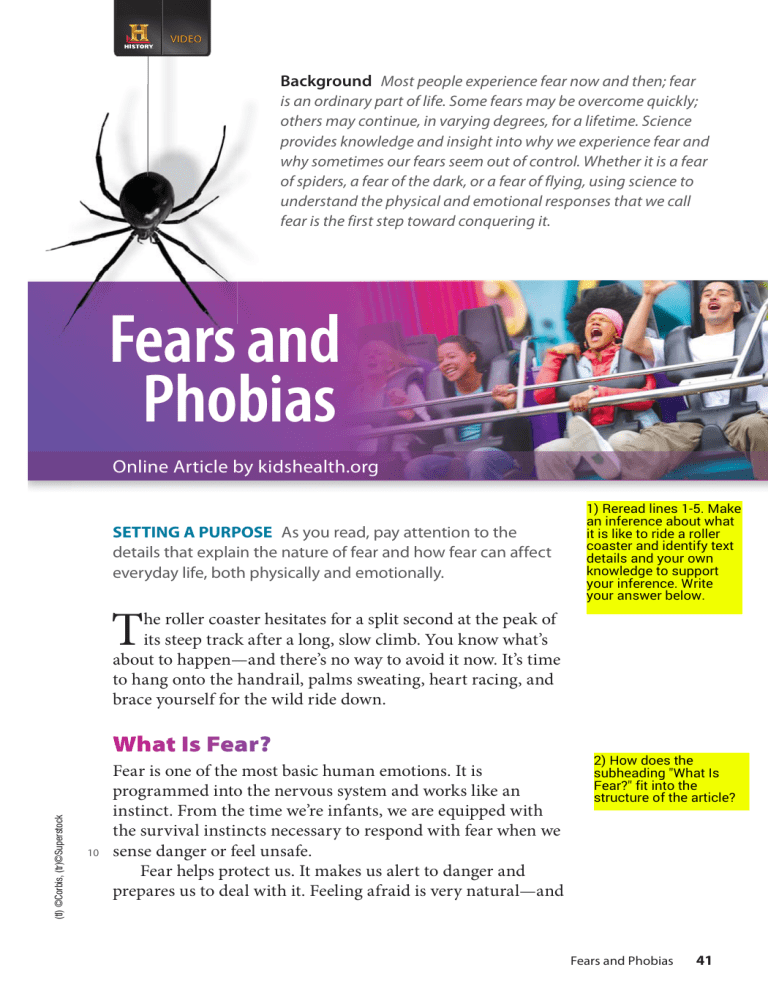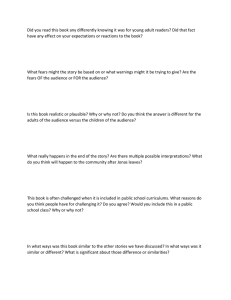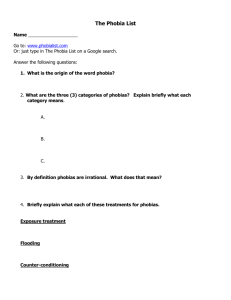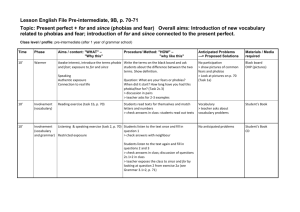Fears and Phobias Article
advertisement

VIDEO Background Most people experience fear now and then; fear is an ordinary part of life. Some fears may be overcome quickly; others may continue, in varying degrees, for a lifetime. Science provides knowledge and insight into why we experience fear and why sometimes our fears seem out of control. Whether it is a fear of spiders, a fear of the dark, or a fear of flying, using science to understand the physical and emotional responses that we call fear is the first step toward conquering it. Fears and Phobias Online Article by kidshealth.org SETTING A PURPOSE As you read, pay attention to the details that explain the nature of fear and how fear can affect everyday life, both physically and emotionally. 1) Reread lines 1-5. Make an inference about what it is like to ride a roller coaster and identify text details and your own knowledge to support your inference. Write your answer below. T he roller coaster hesitates for a split second at the peak of its steep track after a long, slow climb. You know what’s about to happen—and there’s no way to avoid it now. It’s time to hang onto the handrail, palms sweating, heart racing, and brace yourself for the wild ride down. (tl) ©Corbis, (tr)©Superstock Wha at Iss Fe ear? ? 10 Fear is one of the most basic human emotions. It is programmed into the nervous system and works like an instinct. From the time we’re infants, we are equipped with the survival instincts necessary to respond with fear when we sense danger or feel unsafe. Fear helps protect us. It makes us alert to danger and prepares us to deal with it. Feeling afraid is very natural—and 2) How does the subheading "What Is Fear?" fit into the structure of the article? Fears and Phobias 41 helpful—in some situations. Fear can be like a warning, a signal that cautions us to be careful. Like all emotions, fear can be mild, medium, or intense, depending on the situation and the person. A feeling of fear can be brief or it can last longer. How Fearr Worrks 20 30 When we sense danger, the brain reacts instantly, sending signals that activate the nervous system. This causes physical responses, such as a faster heartbeat, rapid breathing, and an increase in blood pressure. Blood pumps to muscle groups to prepare the body for physical action (such as running or fighting). Skin sweats to keep the body cool. Some people might notice sensations in the stomach, head, chest, legs, or hands. These physical sensations of fear can be mild or strong. This response is known as “fight or flight” because that is exactly what the body is preparing itself to do: fight off the danger or run fast to get away. The body stays in this state of fight-flight until the brain receives an “all clear” message and turns off the response. Sometimes fear is triggered by something that is startling or unexpected (like a loud noise), even if it’s not actually dangerous. That’s because the fear reaction is activated instantly—a few seconds faster than the thinking part of the brain can process or evaluate what’s happening. As soon as the brain gets enough information to realize there’s no danger (“Oh, it’s just a balloon bursting—whew!”), it turns off the fear reaction. All this can happen in seconds. FEAR OR FUN N? Some people find the rush of fear exciting. They might seek out the thrill of extreme sports and savor the scariest horror flicks. Others do not like the experience of feeling afraid or taking risks. During the scariest moments of a roller coaster ride one person might think, “I’ll never get on this thing again—that is, if I make it out alive!” while another person thinks, “This is awesome! As soon as it’s over, I’m getting back on!” 42 Collection 1 activate (√k´t∂-v∑t´) v. To activate something means to cause it to start working. 3) Reread lines 26-29 and find the two phrases in quotation marks. What do each of these phrases mean? Why are they emphasized this way? trigger (trΔg´∂r) v. To trigger something means to cause it to begin. 4) After you read the sidebar "FEAR OR FUN?" explain how the ideas in it differ from the rest of the article but are still related to it. Fearrs Pe eoplle Have e 40 50 60 Fear is the word we use to describe our emotional reaction to something that seems dangerous. But the word “fear” is used in another way, too: to name something a person often feels afraid of. People fear things or situations that make them feel unsafe or unsure. For instance, someone who isn’t a strong swimmer might have a fear of deep water. In this case, the fear is helpful because it cautions the person to stay safe. Someone could overcome this fear by learning how to swim safely. A fear can be healthy if it cautions a person to stay safe around something that could be dangerous. But sometimes a fear is unnecessary and causes more caution than the situation calls for. Many people have a fear of public speaking. Whether it’s giving a report in class, speaking at an assembly, or reciting lines in the school play, speaking in front of others is one of the most common fears people have. People tend to avoid the situations or things they fear. But this doesn’t help them overcome fear—in fact, it can be the reverse. Avoiding something scary reinforces a fear and keeps it strong. People can overcome unnecessary fears by giving themselves the chance to learn about and gradually get used to the thing or situation they’re afraid of. For example, people who fly despite a fear of flying can become used to unfamiliar sensations like takeoff or turbulence. They learn what to expect and have a chance to watch what others do to relax and enjoy the flight. Gradually (and safely) facing fear helps someone overcome it. Fearrs Durrin ng Childh hood 70 5) How are the two subheadings on this page related? How do they help a reader understand the information that follows them? turbulence (tûr´by∂-l∂ns) n. In flying, turbulence is an interruption in the flow of wind that causes planes to rise, fall, or sway in a rough way. Certain fears are normal during childhood. That’s because fear can be a natural reaction to feeling unsure and vulnerable— and much of what children experience is new and unfamiliar. Young kids often have fears of the dark, being alone, strangers, and monsters or other scary imaginary creatures. School-aged kids might be afraid when it’s stormy or at a first sleepover. As they grow and learn, with the support of adults, most kids are able to slowly conquer these fears and outgrow them. Fears and Phobias 43 80 Some kids are more sensitive to fears and may have a tough time overcoming them. When fears last beyond the expected age, it might be a sign that someone is overly fearful, worried, or anxious. People whose fears are too intense or last too long might need help and support to overcome them. Phobiass 90 100 A phobia is an intense fear reaction to a particular thing or a situation. With a phobia, the fear is out of proportion to the potential danger. But to the person with the phobia, the danger feels real because the fear is so very strong. Phobias cause people to worry about, dread, feel upset by, and avoid the things or situations they fear because the physical sensations of fear can be so intense. So having a phobia can interfere with normal activities. A person with a phobia of dogs might feel afraid to walk to school in case he or she sees a dog on the way. Someone with an elevator phobia might avoid a field trip if it involves going on an elevator. A girl with a phobia of thunderstorms might be afraid to go to school if the weather forecast predicts a storm. She might feel terrible distress and fear when the sky turns cloudy. A guy with social phobia experiences intense fear of public speaking or interacting, and may be afraid to answer questions in class, give a report, or speak to classmates in the lunchroom. It can be exhausting and upsetting to feel the intense fear that goes with having a phobia. It can be disappointing to miss out on opportunities because fear is holding you back. And it can be confusing and embarrassing to feel afraid of things that others seem to have no problem with. Sometimes, people get teased about their fears. Even if the person doing the teasing doesn’t mean to be unkind and unfair, teasing only makes the situation worse. Wha at Ca ause es Phob bia as? 110 44 Some phobias develop when someone has a scary experience with a particular thing or situation. A tiny brain structure called the amygdala (pronounced: uh-mig-duh-luh) keeps track of experiences that trigger strong emotions. Once a certain thing or situation triggers a strong fear reaction, the amygdala warns the person by triggering a fear reaction every Collection 1 6) What does amygdala mean and what is its function in the body? © Uli Wiesmeier/Corbis 120 time he or she encounters (or even thinks about) that thing or situation. Someone might develop a bee phobia after being stung during a particularly scary situation. For that person, looking at a photograph of a bee, seeing a bee from a distance, or even walking near flowers where there could be a bee can all trigger the phobia. Sometimes, though, there may be no single event that causes a particular phobia. Some people may be more sensitive to fears because of personality traits they are born with, certain genes1 they’ve inherited, or situations they’ve experienced. People who have had strong childhood fears or anxiety may be more likely to have one or more phobias. Having a phobia isn’t a sign of weakness or immaturity. It’s a response the brain has learned in an attempt to protect the person. It’s as if the brain’s alert system triggers a false alarm, generating intense fear that is out of proportion to the 1 immaturity (Δm´∂-ty≥r´Δ-t∏) n. Immaturity is the state of not being fully developed or grown. genes (j∏nz): the parts of cells that give a living thing its physical characteristics and make it grow and develop; a person’s genes come from their parents and other blood relatives. Fears and Phobias 45 130 situation. Because the fear signal is so intense, the person is convinced the danger is greater than it actually is. 7) Review the article's subheadings in order from beginning to end. Explain the sequence of ideas the subheadings of each section show. Overcom ming g Phob bia as 140 150 160 People can learn to overcome phobias by gradually facing their fears. This is not easy at first. It takes willingness and bravery. Sometimes people need the help of a therapist2 to guide them through the process. Overcoming a phobia usually starts with making a long list of the person’s fears in least-to-worst order. For example, with a dog phobia, the list might start with the things the person is least afraid of, such as looking at a photo of a dog. It will then work all the way up to worst fears, such as standing next to someone who’s petting a dog, petting a dog on a leash, and walking a dog. Gradually, and with support, the person tries each fear situation on the list—one at a time, starting with the least fear. The person isn’t forced to do anything and works on each fear until he or she feels comfortable, taking as long as needed. A therapist could also show someone with a dog phobia how to approach, pet, and walk a dog, and help the person to try it, too. The person may expect terrible things to happen when near a dog. Talking about this can help, too. When people find that what they fear doesn’t actually turn out to be true, it can be a great relief. A therapist might also teach relaxation practices such as specific ways of breathing, muscle relaxation training, or soothing self-talk. These can help people feel comfortable and bold enough to face the fears on their list. As somebody gets used to a feared object or situation, the brain adjusts how it responds and the phobia is overcome. Often, the hardest part of overcoming a phobia is getting started. Once a person decides to go for it—and gets the right coaching and support—it can be surprising how quickly fear can melt away. COLLABORATIVE DISCUSSION Fears and phobias are related, but they are quite different in some ways. With a partner, use evidence from the text to discuss these differences. Which response can be useful? Which one can be harmful, and why? 2 46 therapist (th≈r´∂-pΔst): a person who is skilled in treating mental or physical illness. Collection 1 8) Reread lines 132-158 and explain how the important ideas and details in this last section connect to the rest of the article. EL A RI.6.1 ELD PI.6.6 Cite Evidence To support analysis of any text that you read, you need to be able to cite evidence, or provide specific information from the text. Evidence can include details, facts, statistics, quotations, and examples. The chart shows different ways to cite evidence from an informational text such as “Fears and Phobias.” If you want to . . . Then . . . support an idea, opinion, conclusion, or inference, cite selected words and details from anywhere in the text. analyze how a text is organized, cite sentences that include signal words that indicate a pattern of organization, such as first and after for chronological order. summarize the main idea and details in a text, cite details from specific sections of the text. After reading “Fears and Phobias,” imagine that you came to the conclusion that when we are afraid, our bodies respond in many ways. To support your conclusion, you could cite lines 18–25 as examples from the text. EL A RI.6.5 ELD PII.6.1 Analyze Structure Text features are design elements such as boldface type and headings that highlight the organization and important information in a text. You can use text features to get an idea of the topics in a text. They can also help you locate particular topics or ideas after reading. Text features include: t A heading is a kind of title that identifies the topic of the content that follows it. Headings often appear at the beginning of a chapter or article. t A subheading is a kind of title that usually indicates the beginning of a new topic or section within a chapter or article. A subheading helps you identify the main idea of the text that follows. t A sidebar is additional information that is usually set in a box alongside or within an article. Analyze text features by asking yourself these questions: t What text features does the text include? t Which features help me preview and locate main ideas in the text? t How does information under a particular heading fit into the whole text? What important ideas does it contain? Fears and Phobias 47 eBook Analyzing the Text Cite Text Evidence EL A RI.6.1, RI.6.3, RI.6.5, RI.6.6, W.6.2, W.6.4 ELD PI.6.6, PI.6.7, PI.6.10, PII.6.1 Support your responses with evidence from the text. 1. Cause/Effect Events are often related by cause and effect: one event brings about the other. The event that happens first is the cause; the one that follows is the effect. Reread lines 18–38. Examine the text and identify examples of cause-and-effect relationships. 2. Cite Evidence What causes phobias? Cite evidence from the text that explains where phobias come from. 3. Draw Conclusions Review lines 132–162. What factors are important in helping people overcome phobias? Explain whether the author believes it is worthwhile to try to overcome phobias and why. 4. Compare Explain how a fear is different from a phobia. Identify examples of each that the author presents. 5. Interpret What additional information does the sidebar provide? How does it add to your understanding of the article? 6. Analyze Use the headings in “Fears and Phobias” to examine the main ideas the author presents. In your own words, describe the way the author orders the information. PERFORMANCE TASK Writing Activity: Summary Write a summary of “Fears and Phobias.” A summary is a brief retelling of a text in your own words. You should cover only the main ideas and most important details. Your summary should be no more than one-third the length of the original text. t Review the article to identify the main ideas. 48 Collection 1 t Introduce the summary by writing a topic sentence that explains the main purpose of the article. t Tell what a fear is, what a phobia is, and how they are different. Cite evidence from the text. t Conclude your summary by telling why the article is useful or important. EL A L.6.4a, L.6.4b, L.6.4d, L.6.6 ELD PI.6.6, PI.6.12 Critical Vocabulary activate trigger turbulence immaturity Practice and Apply Answer each question and explain your response. 1. Which of the following is an example of activate? Why? unplugging a computer pressing the power button on a computer 2. Which of the following is most likely to trigger an allergy? Why? getting stung by a bee watching a movie about bees 3. Which of the following involves turbulence? Why? a canoe trip on a quiet lake a canoe trip on a rushing, rocky river 4. Which of the following is an example of immaturity? Why? explaining why you are upset crying when you don’t get your way Vocabulary Strategy: Prefixes That Mean “Not” A prefix is a word that appears at the beginning of a base word to form a new word. Many prefixes that mean ”not” come from Latin, the language of ancient Rome. One example is the vocabulary word immaturity (im + maturity). To figure out the meaning of a word that contains a prefix and a base word, follow these steps. t Think of the meaning of each word part separately. t Use this information as well as context clues to define the word. Prefix Meaning Prefix Meaning in- not; in non- not mis- not; incorrectly un- not; opposite of Practice and Apply Use the prefixes in the chart and context clues to help you determine a meaning for the boldface word in each sentence. 1. Not having Sunday hours at the library is inconvenient for people who work during the week. 2. The group agreed that their protest would be a nonviolent one. 3. Being late to the party was unintentional; we were stuck in traffic! 4. The careless reporter misquoted the mayor’s remarks. Fears and Phobias 49 EL A L.6.1a ELD PII.6.2 Language Conventions: Subjective and Objective Pronouns A pronoun is a word that takes the place of a noun or another pronoun. Personal pronouns take different forms, or cases, depending on how they are used in a sentence. A pronoun in the subjective case is one that is used as the subject of a sentence. A pronoun in the objective case is one that is used as an object of a verb or preposition. Here are some examples from “Fears and Phobias.” Subjective Case: It is programmed into the nervous system. Objective Case: Fear helps protect us. Pronouns can also be singular or plural in number. This chart shows the singular and plural forms of the subjective and objective case. Subjective Singular Plural Objective First person I me Second person you you Third person she, he, it her, him, it First person we us Second person you you Third person they them Pronouns can be misused, especially in compound subjects and objects. Use a subject pronoun if the pronoun is part of a compound subject. Use an object pronoun if the pronoun is part of a compound object. Practice and Apply Choose the correct pronoun to complete each sentence. 1. Carlos took swimming lessons to help (him, it) overcome a fear of deep water. 2. When some people experience extreme fear, (you, they) may feel sick or dizzy. 3. I do not like small spaces. Being in an elevator makes (her, me) very anxious. 4. Danielle and Ramon explained how (he, they) use breathing exercises to help stay relaxed. 5. Leia and (I, me) are sometimes teased about our fears. 50 Collection 1


